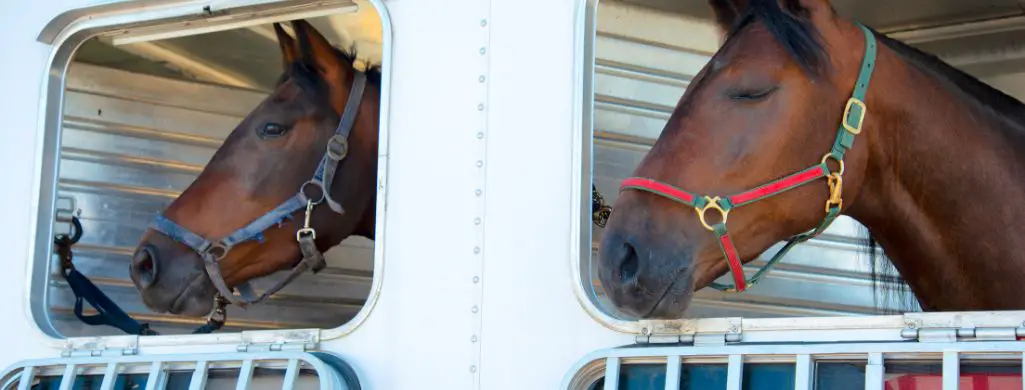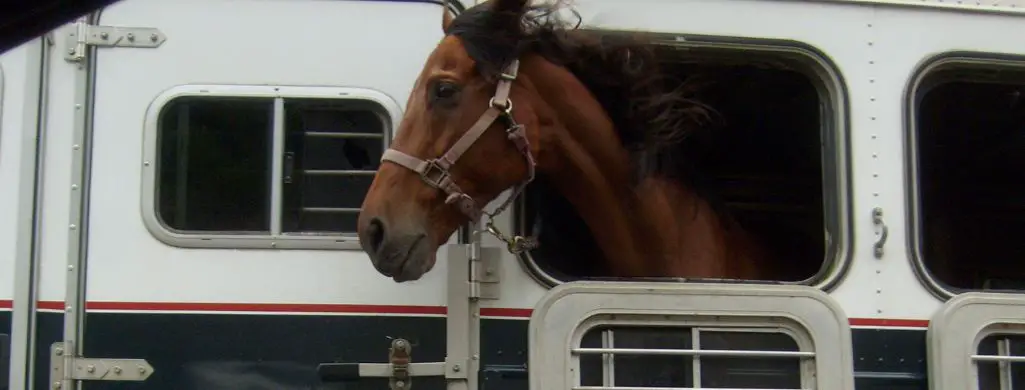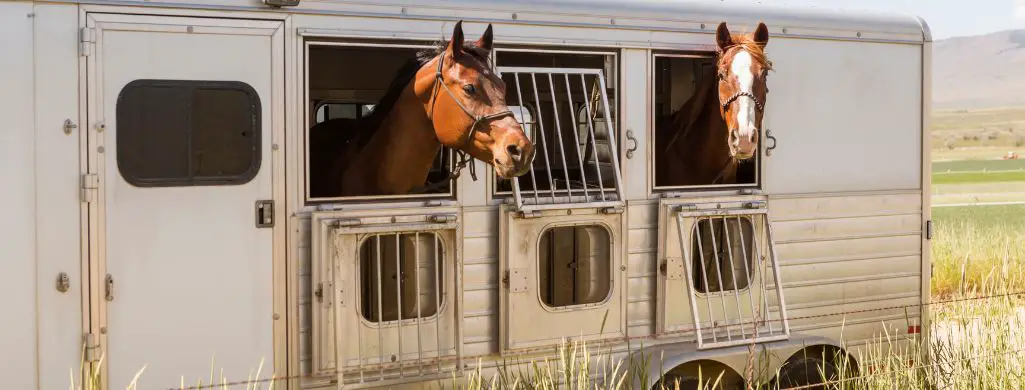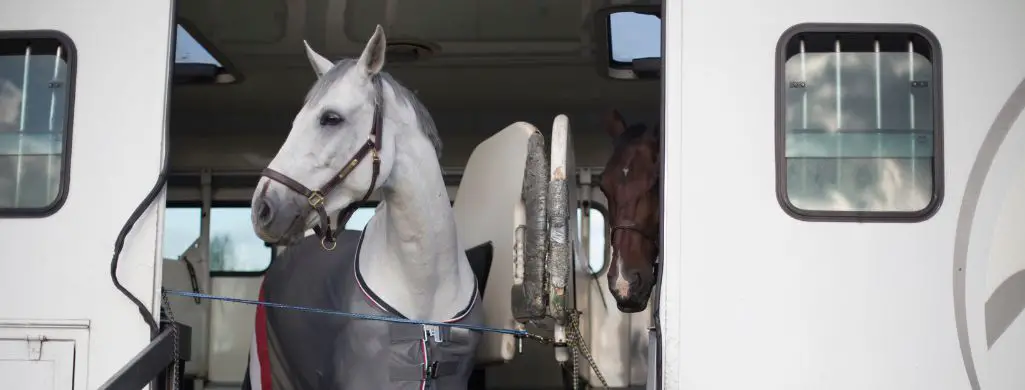As a horse owner, you know that transporting to events or even just to new pastures can be a stressful and potentially unsafe experience for your horse. Discover how long can a horse safely travel in a trailer while learning the factors affecting travel duration, preparation tips, legal considerations, and more.

- Key Takeaways:
- The Basics: how long can a horse safely travel in a trailer?
- Preparing your Horse for Travel
- Types of Trailers and Their Impact on Travel Time
- Legal Considerations When Transporting Horses
- Signs that Your Horse Needs to Take a Break
- Indicators that Your Horse is Experiencing Discomfort or Stress During Transportation
- Steps You Should Take if You Notice Any Concerning Signs
- The importance of safe and comfortable transportation for horses
Key Takeaways:
- The length of time a horse can safely stay in a trailer depends on factors such as age, health, temperament, fitness level, and overall trailer conditions. Generally, horses should not be transported for more than 8-10 hours without rest.
- Proper preparation is important before loading a horse into a trailer, including gradually introducing them to the trailer environment and practicing loading multiple times. Positive reinforcement and working with a trainer can help ease the process.
- Proper ventilation, temperature control, and access to water are crucial for the comfort and safety of horses during transportation. Owners should take steps to ensure these factors are addressed.
- The type of trailer used for transporting horses, such as straight load, slant load, or stock trailer, can impact travel time and comfort. Each type has its pros and cons, and the choice should be based on the horse’s comfort level and personal preference.
- Transporting horses is not only a matter of safety but also a legal issue. State laws regulate rest breaks and space requirements for horses during transportation, while federal regulations apply to commercial haulers. It’s important to be aware of and comply with these regulations to ensure the welfare of the animals and avoid legal penalties.
The Basics: how long can a horse safely travel in a trailer?
Transporting a horse can be a stressful experience for both the animal and the owner. One of the most important things to consider when transporting a horse is how long they can safely remain in a trailer. The recommended maximum duration for transporting horses is 12 hours, but this varies based on several factors.
One of the most significant factors that determine how long a horse can stay in a trailer without causing harm is the age and health of the animal. Younger horses with developing bones and immune systems are much more susceptible to stress than adult horses.
Similarly, older horses with preexisting health conditions may not tolerate prolonged periods of transportation as well as younger, healthier animals. It’s important to consult with your veterinarian before undertaking any long-distance trips with your horse to ensure that they are healthy enough to handle it.
Another factor that influences how long a horse can safely stay in a trailer is their temperament. Horses who are particularly nervous or high-strung may not tolerate travel as well as more laid-back animals.
Monitor your horse’s body language and behavior during transportation to ensure that they are comfortable and calm throughout the journey. Proper ventilation, temperature control, and access to water also play important roles in keeping horses safe and comfortable during transportation.
Preparing your Horse for Travel

Tips on how to prepare your horse mentally and physically before loading them into a trailer
Transporting horses can be stressful for them, especially if they are not used to it. It’s important to take some time and prepare your horse both mentally and physically before loading them into the trailer.
One way you can do this is by gradually introducing your horse to the trailer environment. This includes allowing them to sniff around the interior and become familiar with it.
Give them time to get comfortable in there before you close it up. Another tip is to practice loading your horse onto the trailer several times before traveling long distances.
This will help desensitize your horse to the process of getting on the trailer, making things easier when it comes time for travel day. You can use treats or rewards as positive reinforcement when they get in or work with a trainer who specializes in teaching horses how to load.
The importance of proper ventilation, temperature control, and hydration during transportation
When transporting horses long distances it’s important that they have access to appropriate ventilation. A poorly ventilated trailer can cause respiratory problems including coughing, nasal discharge, or even pneumonia in extreme cases. Controlling temperature is also important when transporting horses.
During hot summer months keep windows open and fans running while avoiding transporting during peak heat times (usually midday). During colder months provide blankets for horses while also making sure they don’t overheat from excess layers.
Horses should also have access to water throughout transportation which requires regular stops or a water source available within trailers if available. Properly preparing a horse for travel ensures their safety preventing unnecessary stress injuries such as slips on wet floors or falls caused by unstable footing or sudden movements which would prevent further harm.

Types of Trailers and Their Impact on Travel Time
When you’re transporting a horse, one of the most important factors to consider is the type of trailer you’ll be using. Not all trailers are created equal, and some are better suited for long-distance travel than others. Before making your choice, it’s important to understand the pros and cons of each type.
Straight Load Trailers
A straight load trailer is designed so that horses face forward during transport. They enter through a rear ramp or side ramp and stand in stalls that run parallel to the length of the trailer. Straight load trailers are often preferred by owners because they provide more headroom for the horse, allowing them to move around easily.
However, these trailers can be heavy and difficult to maneuver due to their size. Also, some horses may feel trapped if they are not comfortable in confined spaces.
Slant Load Trailers
Slant-load trailers position horses at a slight angle while traveling. This design allows more horses to be transported at once as there is generally less space taken up with aisles between stalls. Slant-load trailers have smaller turning radiuses which makes them easier to maneuver in tight spaces. The downside is that these types of trailers tend to be narrower than straight-load ones resulting in less headroom for tall horses. Slant-load trailers also have fewer windows which can make them feel dark inside which might upset some horses.
Stock Trailers
A stock trailer is an open-sided trailer without stalls or dividers where horses can move around freely during transport. This design allows for ample ventilation thanks to its open sides but lacks security features such as dividers and walls which can make your horse feel unsafe or insecure during transport. Some owners prefer stock trailers when transporting larger breeds or pregnant mares as it allows them to move around more freely while in transit. The type of trailer you choose will largely depend on your horse’s comfort level as well as your personal preference and what you have available.
Take time to carefully consider each option and keep in mind the distances you’ll be traveling and the number of horses that need transportation. By choosing a trailer that meets all your needs, you can ensure a smooth and stress-free journey for both you and your horse.

Legal Considerations When Transporting Horses
Traveling with horses can be an incredibly thrilling experience! However, it’s important to be aware of the regulations and requirements associated with horse travel. When you’re traveling with your horse within state boundaries, you’ll only need one document, which is the “proof of ownership” certificate. But if you’re planning to transport your horse across state lines, there are additional regulatory laws that you need to consider.
To ensure the safety and well-being of the livestock population and prevent theft, the state from which you’re departing governs the brand inspections. As part of these regulations, you’ll need a health certificate from your veterinarian. This official document states that your horse is healthy and fit to travel from your starting point to your destination.
It’s important to note that almost all U.S. states require horse owners or professional shippers to carry proper documentation when moving horses within and across state lines. This documentation includes proof that each animal has tested negative for equine infectious anemia and has been examined by a veterinarian within a specific timeframe prior to travel.
Remember, these regulations are in place to ensure the safety and well-being of your horse as well as the overall equine community. By following these guidelines, you’ll have a smoother and more enjoyable travel experience with your four-legged companion!
Signs that Your Horse Needs to Take a Break
Transporting a horse for long distances can be a stressful experience for both the animal and the handler. Horses are sensitive creatures, and it’s essential to monitor them during transportation to ensure they’re comfortable and safe.
But how do you know when your horse needs to take a break while traveling in a trailer? One of the most common signs is restlessness.
If your horse is continually moving around or trying to shift their weight while in the trailer, it may be time for a break. Other symptoms may include sweating, panting, or rapid breathing rate, all of which are indications that your horse is experiencing discomfort or stress.
Indicators that Your Horse is Experiencing Discomfort or Stress During Transportation
There are several indicators that your horse might be experiencing discomfort or stress during transportation in a trailer. In addition to restlessness and rapid breathing rate as mentioned earlier, another sign is reluctance to enter the trailer after stopping at rest areas. If your horse appears hesitant or overly anxious about getting back into the trailer, this could indicate some underlying discomfort.
Other signs include pawing at the ground repeatedly (as if trying to warn you something isn’t right), excessive sweating even when temperatures aren’t high enough for such behavior, and foaming at the mouth which could indicate nervousness due to anxiety-inducing situations such as sudden stops or turns of roads. If you notice any of these signs while transporting your horse, it’s important to take prompt action.

Steps You Should Take if You Notice Any Concerning Signs
If you notice any concerning signs that your horse may need an immediate break from travel inside the trailer during transportation like those listed above, stop immediately when safe! Find an area where there’s enough space for both you and your animal friend out of sight from oncoming traffic, and give them a chance to stretch their legs. It’s important to provide your horse with enough water during these breaks as well, especially if the weather is hot or humid.
After giving your horse a break, it’s crucial to assess its condition before getting back in the trailer. Check for any signs of injury or unnecessary sweating that might indicate an underlying problem.
If everything appears normal and your horse is willing to continue the journey, then you can proceed with caution. Monitoring your horse’s behavior during transportation in a trailer is important for their safety and well-being.
Always be aware of any concerning signs and take prompt action if necessary. With the right preparation and attention to detail, you can ensure that your horse stays healthy and happy during long-distance transportation.
The importance of safe and comfortable transportation for horses
Transporting a horse can be a stressful experience for the animal. As owners, it’s our responsibility to ensure their safety and comfort during the journey. After reading this article, you should have a better understanding of how long a horse can be in a trailer without causing harm and what steps you can take to make the journey as smooth as possible.
Remember that every horse is different, so it’s important to take their individual needs into consideration. Taking steps such as preparing your horse mentally and physically before travel, ensuring proper ventilation and temperature control within the trailer, and recognizing signs that your horse needs a break are all important aspects of responsible transportation.
By following best practices for safe transportation, you can rest easy knowing that your horse is happy and healthy throughout the journey. So don’t let fear or uncertainty hold you back from exploring new horizons with your four-legged friend – with some preparation and care, anything is possible!








